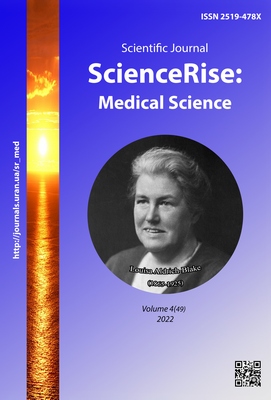Роль імунологічних факторів в патогенезі аномальних маткових кровотеч у жінок репродуктивного віку з екстрагенітальною патологією
DOI:
https://doi.org/10.15587/2519-4798.2022.262184Ключові слова:
аномальні маткові кровотечі, імунна система, антитромбоцитарні автоантитіла, фагоцитарні реакції, гуморальна сенсибілізаціяАнотація
Метою представленої роботи є дослідження ролі імунологічних факторів в патогенезі аномальних маткових кровотеч у жінок репродуктивного віку з екстрагенітальною патологією.
Матеріали та методи. Обстежено 100 жінок з аномальними матковими кровотечами та супутньою екстрагенітальною патологією (основна група) та 50 соматично здорових жінок (контрольна група). В якості імунологічних маркерів оцінювали – автоімунні антитіла до тромбоцитів, фагоцитарну активність нейтрофільних гранулоцитів, концентрацію циркулюючих імунних комплексів (ЦІК), сумарний рівень мембранотропних цитотоксичних факторів, вміст СD4+Т-хелперної субпопуляцій та цитотоксичних CD8+-Т-кілерних лімфоцитів.
Результати дослідження. Під час дослідження з’ясовано, що одним із патогенетичних факторів кровотеч у жінок з АМК може бути тромбоцитопенія, зумовлена наявністю автоімунних антитіл до власних тромбоцитів. У 41 % жінок з АМК виявили напруженість фагоцитарних реакцій, що виражалось підвищенням функцій хемотаксису та адгезії, а у 46 % жінок – підвищенням поглинаючої здатності фагоцитів. В основній групі у 48 % обстежених жінок мала місце недостатність ензимної активності фагоцитів, про що свідчило зниження індексу завершення фагоцитозу. У 79 % жінок основної групи виявили порушення утворення та елімінації циркулюючих імунних комплексів. Формування низькомолекулярних ЦІК у 82 % жінок даної когорти сприяло індукції автоімунних реакцій. Сумарний вміст мембранотропних цитотоксичних факторів, який оцінювали за показниками лімфоцитотоксичного тесту, у 88 % жінок основної групи перевищував референтні значення. В основній групі середній вміст СD4+Т-хелперів був нижчим на 23 %, а вміст супресорних CD8+ Т-лімфоцитів удвічі нижчим відносно контрольної групи, що зумовило достовірне підвищення імунорегуляторного індексу на 30 %.
Висновок. У жінок основної групи з аномальними матковими кровотечами виявлено порушення функціональної активності клітинних факторів вродженого імунітету, що супроводжувались змінами поглинаючої та травної здатності фагоцитуючих клітин . З боку вторинних адаптивних реакцій виявили індукцію гуморальної сенсибілізації та формування автоімунних реакцій (наявність антитромбоцитарних автоантитіл, підвищення ЦІК та ЛЦТ, зниження субпопуляції CD8+-супресорних Т-лімфоцитів). Виявлені порушення вказують на патогенетичну роль імунологічних реакцій у жінок з аномальними матковими кровотечами
Посилання
- ACOG committee opinion no. 557: Management of acute abnormal uterine bleeding in nonpregnant reproductive-aged women (2013). Obstetrics and gynecology, 121 (4), 891–896. doi: http://doi.org/10.1097/01.aog.0000428646.67925.9a
- Kazemijaliseh, H., Ramezani Tehrani, F., Behboudi-Gandevani, S., Khalili, D., Hosseinpanah, F., Azizi, F. (2017). A Population-Based Study of the Prevalence of Abnormal Uterine Bleeding and its Related Factors among Iranian Reproductive-Age Women: An Updated Data. Archives of Iranian medicine, 20 (9), 558–563.
- Marie, K., Cyrille, N., Etienne, B., Pascal, F. (2020). Epidemiological Profile of Abnormal Uterine Bleeding at the Gyneco-Obstetric and Pediatric Hospital of Yaounde. Open Journal of Obstetrics and Gynecology, 10, 237–242. doi: http://doi.org/10.4236/ojog.2020.1020020
- Whitaker, L., Critchley, H. O. (2016). Abnormal uterine bleeding. Best practice & research. Clinical obstetrics & gynaecology, 34, 54–65. doi: http://doi.org/10.1016/j.bpobgyn.2015.11.012
- Singh, S., Best, C., Dunn, S., Leyland, N., Wolfman, W. L. et. al. (2013). Abnormal uterine bleeding in pre-menopausal women. Journal of obstetrics and gynaecology Canada, 35 (5), 473–475. doi: http://doi.org/10.1016/s1701-2163(15)30939-7
- Iniyaval, R., Jayanthi, B., Lavanya, S., Renuka K. (2021). A Study to Assess the Prevalence and Contributing Factors of Abnormal Uterine Bleeding among Women Admitted in MGMCRI from January to December 2019. Pondicherry Journal of Nursing, 14 (1), 8–10. doi: http://doi.org/10.5005/jp-journals-10084-12173
- de Léotoing, L., Chaize, G., Fernandes, J., Toth, D., Descamps, P., Dubernard, G. et. al. (2019). The surgical treatment of idiopathic abnormal uterine bleeding: An analysis of 88 000 patients from the French exhaustive national hospital discharge database from 2009 to 2015. PloS one, 14 (6), e0217579. doi: http://doi.org/10.1371/journal.pone.0217579
- Schoep, M. E., Adang, E., Maas, J., De Bie, B., Aarts, J., Nieboer, T. E. (2019). Productivity loss due to menstruation-related symptoms: a nationwide cross-sectional survey among 32 748 women. BMJ open, 9 (6), e026186. doi: http://doi.org/10.1136/bmjopen-2018-026186
- Bennett, A., Thavorn, K., Arendas, K., Coyle, D., Singh, S. S. (2020). Outpatient uterine assessment and treatment unit in patients with abnormal uterine bleeding: an economic modelling study. CMAJ open, 8 (4), E810–E818. doi: http://doi.org/10.9778/cmajo.20190170
- Hale, K. (2018). Abnormal Uterine Bleeding: A Review. US Pharm, 43 (9), HS2–HS9
- Alzahrani, F., Hassan, F. (2019). Modulation of Platelet Functions Assessment during Menstruation and Ovulatory Phases. Journal of medicine and life, 12 (3), 296–300. doi: http://doi.org/10.25122/jml-2019-0005
- Dickerson, K. E., Menon, N. M., Zia, A. (2018). Abnormal Uterine Bleeding in Young Women with Blood Disorders. Pediatric clinics of North America, 65 (3), 543–560. doi: http://doi.org/10.1016/j.pcl.2018.02.008
- Kristina, M., Lattimore, S., McDavitt, С., Khader, A., Boehnlein, C., Baker-Groberg, S. et. al. (2016). Haley Identification of Qualitative Platelet Disorders in Adolescent Women with Heavy Menstrual Bleeding. Blood, 22 (128), 4922. doi: http://doi.org/10.1182/blood.v128.22.4922.4922
- Amesse, L. S., Pfaff-Amesse, T., Gunning, W. T., Duffy, N., French, J. A. (2013). Clinical and laboratory characteristics of adolescents with platelet function disorders and heavy menstrual bleeding. Experimental hematology & oncology, 2 (1), 3. doi: http://doi.org/10.1186/2162-3619-2-3
- Critchley, H., Maybin, J. A., Armstrong, G. M., Williams, A. (2020). Physiology of the Endometrium and Regulation of Menstruation. Physiological reviews, 100 (3), 1149–1179. doi: http://doi.org/10.1152/physrev.00031.2019
- Alaqzam, T. S., Stanley, A. C., Simpson, P. M., Flood, V. H., Menon, S. (2018). Treatment Modalities in Adolescents Who Present with Heavy Menstrual Bleeding. Journal of pediatric and adolescent gynecology, 31 (5), 451–458. doi: http://doi.org/10.1016/j.jpag.2018.02.130
- Schatz, F., Guzeloglu-Kayisli, O., Arlier, S., Kayisli, U. A., Lockwood, C. J. (2016). The role of decidual cells in uterine hemostasis, menstruation, inflammation, adverse pregnancy outcomes and abnormal uterine bleeding. Human reproduction update, 22 (4), 497–515. doi: http://doi.org/10.1093/humupd/dmw004
- Maybin, J. A., Murray, A. A., Saunders, P., Hirani, N., Carmeliet, P., Critchley, H. (2018). Hypoxia and hypoxia inducible factor-1α are required for normal endometrial repair during menstruation. Nature communications, 9 (1), 295. doi: http://doi.org/10.1038/s41467-017-02375-6
- Hapangama, D. K., Bulmer, J. N. (2016). Pathophysiology of heavy menstrual bleeding. Women's health, 12 (1), 3–13. doi: http://doi.org/10.2217/whe.15.81
- Critchley, H., Babayev, E., Bulun, S. E., Clark, S., Garcia-Grau, I., Gregersen, P. K. et. al. (2020). Menstruation: science and society. American journal of obstetrics and gynecology, 223 (5), 624–664. doi: http://doi.org/10.1016/j.ajog.2020.06.004
- Lee, S. K., Kim, C. J., Kim, D. J., Kang, J. H. (2015). Immune cells in the female reproductive tract. Immune network, 15 (1), 16–26. doi: http://doi.org/10.4110/in.2015.15.1.16
- Maybin, J. A., Critchley, H. O. (2015). Menstrual physiology: implications for endometrial pathology and beyond. Human reproduction update, 21 (6), 748–761. doi: http://doi.org/10.1093/humupd/dmv038
- Jabbour, H. N., Sales, K. J., Catalano, R. D., Norman, J. E. (2009). Inflammatory pathways in female reproductive health and disease. Reproduction, 138 (6), 903–919. doi: http://doi.org/10.1530/rep-09-0247
- Lysenko, O. N., Strizhova, N. V., Kholodova, Z. (2003). Parameters of cellular immunity in perimenopausal patients with glandular and adenomatous endometrial hyperplasia. Bulletin of experimental biology and medicine, 135 (1), 77–80. doi: http://doi.org/10.1023/a:1023410332246
- Fraser, I. S., Mansour, D., Breymann, C., Hoffman, C., Mezzacasa, A., Petraglia, F. (2015). Prevalence of heavy menstrual bleeding and experiences of affected women in a European patient survey. International journal of gynaecology and obstetrics: the official organ of the International Federation of Gynaecology and Obstetrics, 128 (3), 196–200. doi: http://doi.org/10.1016/j.ijgo.2014.09.027
- Rodeghiero, F., Marranconi, E. (2020). Management of immune thrombocytopenia in women: current standards and special considerations. Expert Review of Hematology, 13 (2), 175–185. doi: http://doi.org/10.1080/17474086.2020.1711729
- van Dijk, W., Punt, M. C., van Galen, K., van Leeuwen, J., Lely, A. T., Schutgens, R. (2022). Menstrual problems in chronic immune thrombocytopenia: A monthly challenge – a cohort study and review. British journal of haematology, 10. doi: https://doi.org/10.1111/bjh.18291
- Cooper, N., Kruse, A., Kruse, C., Watson, S., Bussel, J. B. (2021). Immune thrombocytopenia (ITP) World Impact Survey (iWISh): Patient and physician perceptions of diagnosis, signs and symptoms, and treatment. American journal of hematology, 96 (2), 188–198. doi: http://doi.org/10.1002/ajh.26045
- Burbano, C., Villar-Vesga, J., Vásquez, G., Muñoz-Vahos, C., Rojas, M., Castaño, D. (2019). Proinflammatory Differentiation of Macrophages Through Microparticles That Form Immune Complexes Leads to T- and B-Cell Activation in Systemic Autoimmune Diseases. Frontiers in immunology, 10, 2058. doi: http://doi.org/10.3389/fimmu.2019.02058
- McInnes, I. B., Schett, G. (2011). The pathogenesis of rheumatoid arthriis. The New England journal of medicine, 365 (23), 2205–2219. doi: http://doi.org/10.1056/nejmra1004965
- Burbano, C., Villar-Vesga, J., Orejuela, J., Muñoz, C., Vanegas, A., Vásquez, G., Rojas, M., Castaño, D. (2018). Potential Involvement of Platelet-Derived Microparticles and Microparticles Forming Immune Complexes during Monocyte Activation in Patients with Systemic Lupus Erythematosus. Frontiers in immunology, 9, 322. doi: http://doi.org/10.3389/fimmu.2018.00322
- Burbano, C., Rojas, M., Vásquez, G., Castaño, D. (2015). Microparticles That Form Immune Complexes as Modulatory Structures in Autoimmune Responses. Mediators of inflammation, 2015. doi: http://doi.org/10.1155/2015/267590
- Mayadas, T. N., Tsokos, G. C., Tsuboi, N. (2009). Mechanisms of immune complex-mediated neutrophil recruitment and tissue injury. Circulation, 120 (20), 2012–2024. doi: http://doi.org/10.1161/circulationaha.108.771170
- Thurman, J. M., Yapa, R. (2019). Complement Therapeutics in Autoimmune Disease. Frontiers in immunology, 10, 672. doi: http://doi.org/10.3389/fimmu.2019.00672
- Kaul, A., Gordon, C., Crow, M. K., Touma, Z., Urowitz, M. B., Ruiz-Irastorza, G. et. al. (2016). Systemic lupus erythematosus. Nature Reviews Disease Primers, 2 (1). doi: http://doi.org/10.1038/nrdp.2016.39
- Yan, M., Marsters, S. A., Grewal, I. S., Wang, H., Ashkenazi, A., Dixit, V. M. (2000). Identification of a receptor for BLyS demonstrates a crucial role in humoral immunity. Nature immunology, 1 (1), 37–41. doi: http://doi.org/10.1038/76889
- Lai, Z. Z., Ruan, L. Y., Wang, Y., Yang, H. L., Shi, J. W., Wu, J. N. et. al. (2020). Changes in subsets of immunocytes in endometrial hyperplasia. American journal of reproductive immunology, 84 (4), e13295. doi: http://doi.org/10.1111/aji.13295
- Witkiewicz, A. K., McConnell, T., Potoczek, M., Emmons, R. V., Kurman, R. J. (2010). Increased natural killer cells and decreased regulatory T cells are seen in complex atypical endometrial hyperplasia and well-differentiated carcinoma treated with progestins. Human pathology, 41 (1), 26–32. doi: http://doi.org/10.1016/j.humpath.2009.06.012
##submission.downloads##
Опубліковано
Як цитувати
Номер
Розділ
Ліцензія
Авторське право (c) 2022 Iryna Tuchkina , Roman Blagoveshchensky

Ця робота ліцензується відповідно до Creative Commons Attribution 4.0 International License.
Наше видання використовує положення про авторські права Creative Commons CC BY для журналів відкритого доступу.
Автори, які публікуються у цьому журналі, погоджуються з наступними умовами:
1. Автори залишають за собою право на авторство своєї роботи та передають журналу право першої публікації цієї роботи на умовах ліцензії Creative Commons CC BY, котра дозволяє іншим особам вільно розповсюджувати опубліковану роботу з обов'язковим посиланням на авторів оригінальної роботи та першу публікацію роботи у цьому журналі.
2. Автори мають право укладати самостійні додаткові угоди щодо неексклюзивного розповсюдження роботи у тому вигляді, в якому вона була опублікована цим журналом (наприклад, розміщувати роботу в електронному сховищі установи або публікувати у складі монографії), за умови збереження посилання на першу публікацію роботи у цьому журналі.










